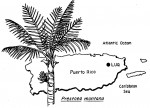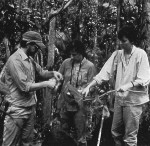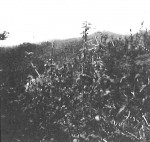With a long tradition of ecosystem-level research, the Luquillo Experimental Forest (LEF) has been the site for over 2500 individual research studies since the Tropical Forest Experiment Station (later to become the International Institute of Tropical Forestry) was founded in 1940. In addition to extensive studies of forest production, the LEF was the focus of an intensive effort by the U.S. Department of Energy (1965-1988) to examine the cycling of chemical elements in a tropical rain forest. The original study in this effort, an examination of the effect of ionizing radiation on forest structure and Function, provided the impetus for subsequent long-term ecosystem research by the International Institute of Tropical Forestry (HTF) and the University of Puerto Rico, leading eventually to the designation of the LEF as a site in the Long-Term Ecological Research (LTER) Network.
When we became part of the LTER network in 1988, we proposed to examine the roles of disturbance and the biota’s response to disturbance as primary factors determining the structure and function of tabonuco (Dacryodes excelsa) forest in Puerto Rico. These twin concepts of disturbance and response continue to provide the unifying theme for the second phase of our longterm ecological research. Our work since 1988 has confirmed the overriding importance of these factors in tabonuco forest and has revealed differences in biotic responses to specific disturbance types and combinations of disturbance.
We have shown that the ecosystems of the Luquillo Experimental Forest (LEF) are dominated by recurrent episodic disturbances such as hurricanes (and isolated high wind and rain events), landslides, and also by events of longer duration such as agricultural activities. These disturbances have different frequencies and severities and result in different pathways of ecosystem response. Because ecosystems in the LEF are so dynamic, physical location alone is an unreliable predictor of ecosystem state. Each point in the landscape incorporates the previous history of natural and anthropogenic disturbances as one of the factors that influence community composition and ecosystem attributes.
Luquillo Riparian Ecosystem Management Project
Research on stream ecosystems conducted under the Luquiilo LTER program has clear and important implications for pubiic policy in Puerto Rico. Increasing population pressure and greater demand for water are factors stressing river systems in Puerto Rico. But inadequate understanding of these systems exists to establish minimum requireci Water flows in streams and adequate precautions to avoid depletion of the biodiversity of streams communities. The Luquillo Riparian Ecosystem Management Project focuses on the relationship between land and water and the linkages between montane and estuarine ecosystems. This project, a collaborative effort between LTER and Forest Service investigators, combines hydrological, ecological, and geomorphological studies to help guide the management of complex ecosystems including both montane streams and their estuaries only 15 km away. Accomplishments of the project include:
- The development of the first Water use budget for the LEF
- Design and testing of a hierarchical stream classification system that has been used to evaluate habitat requirements of aquatic organisms that reside in the LEP
- Development of the forest-wide rainfall-stream runoff-elevation relationship for the LEF
- Calibration of the US-FWS instream flow model on a range of Luquillo streams leading to the development of a habitat-based model using long-term shrimp population data from the Luquillo LTER Program
Trophic Dynamics
More than a decade of research on trophic relationships in tabonuco forest has resulted in a synthesis of the emerging properties of a complex tropical food web. Dominance of the Luquìllo web by ectotherms promotes longer food chains than in other published webs and loops within the web. The absence of mammalian predators decreases the importance of top-down population control. Compartmentalization within the web is caused by physical discontinuities in the habitat as well as day/ night specialization. Connectance within this web is lower than predicted by current theory -- in part due to the long-term nature of the observations provided for the detailed resolution of the web.
Hurricane Response
The immediate (one year) and short-term (five year) responses of a tropical forest ecosystem to a hurricane have been documented by LTER researchers in two special issues of the journal Biotropica. Responses of different ecosystem components five years after Hurricane Hugo fall into six categories:
- Transient increases (e.g., forest floor biomass, some soil nutrient pools, stream nitrate concentration)
- Slow increase and return to prehurricane levels (net primary productivity, abundance of shrimp in streams, frogs, and some terrestrial snails)
- Catastrophic decrease and subsequent rise above pre-hurricane levels (aboveground pools of potassium and magnesium, abundance of the bat Artibeus jamaicensis)
- Catastrophic decrease and return to near pre-hurricane levels (tree biomass and density, abundance of the bat Stenoderma rufum)
- Catastrophic decline and steady increase, but not to within 15% of pre-hurricane levels (total fine lìtterfall)
- Catastrophic decline and little recovery (fine root biomass and the walking stick Lampanius portoricensis
Studies of the response of ecosystems to hurricanes and other types of disturbance will continue to form the core of the Luquillo LTER’s research program in the foreseeable future.

 Enlarge this image
Enlarge this image

